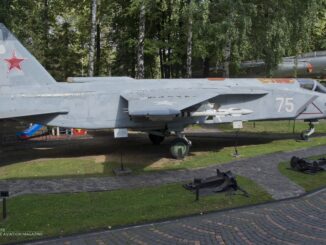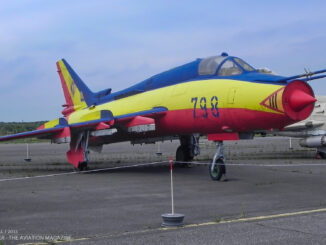 Canadair CF-104 Starfighter (c/n 683A-1033, ´8-733´ of the Turkish Air Force), exhibited at Harbiye Military Museum and Cultural Site Command (Harbiye Askeri Müze ve Kültür Sitesi Komutanlığı), Istanbul, December 2022.
Canadair CF-104 Starfighter (c/n 683A-1033, ´8-733´ of the Turkish Air Force), exhibited at Harbiye Military Museum and Cultural Site Command (Harbiye Askeri Müze ve Kültür Sitesi Komutanlığı), Istanbul, December 2022.
CF-104 was a late development of the Lockheed F-104 Starfighter, manufactured under licence by Canadair. The aircraft was primarily built a nuclear strike aircraft for the Royal Canadian Air Force (RCAF) and was designed on the basis of F-104G air superiority fighter.
At the end of 1950s, Canada significantly increased its commitment to NATO structures and implementation of the nuclear strike aircraft to the RCAF was among direct consequences of that decision. The aircraft was chosen through a multinational competition. Among designs then proposed for the RCAF there were Buccaneer, Mirage IIIC, Fiat G.91, F-104G Starfighter and F-105 Thunderchief.
In 1959, Lockheed was announced the winner and signed a cooperation agreement with Canadair, for joint production of two hundred aircraft. In addition, the Canadian manufacturer was also contracted with making some wing and fuselage elements for the German operated F-104Gs. Maiden flight of the first Canadair-made Starfighter took place in May of 1961. The aircraft received two designations – CL-90 by the manufacturer and CF-111 by the RCAF. However, the latter was shortly after changed to CF-104.
The Canadian-made jets entered operational service in March of 1962. They were based on the F-104G version of the fighter and, similarly to many other Starfighters, were intended for low-level strike and reconnaissance missions – although the jet was initially developed as a high-speed and high-altitude interceptor.
Initially, eight of the RCAF squadrons equipped with the CF-104 Starfighters were deployed to Europe, but their number was then reduced with time – to six in 1967 and only three in 1970.
Similarly to other air forces that used to operate the Starfighter in strike/reconnaissance role the aircraft was not developed for, the RCAF recorded a high accident rate. A total of 110 accidents occurred, including nine mid-air collisions and thirty two hits into terrain. Bad weather conditions concurred to approximately 50% of all tragic events involving the Canadian F-104s, that eventually resulted in loss of thirty seven pilots.
The F-104 Starfighter was operationally used by the Canadian armed forces until 1986, when it was replaced by F/A-18 Hornet. Although the RCAF Starfighters were used extensively, with many airframes exceeding 6,000 flying hours, several aircraft were then sold to other operators, such as Norway, Denmark or Turkey.
Turkey was already operating the Starfighters since 1963, when first fifty four F-104G and TF-104G aircraft were acquired from Lockheed and Canadair. Ten years later, another forty F-104S jets were purchased from Fiat. Nevertheless, the country was also buying several surplus Starfighters from different air forces, finally exceeding a total number of four hundred F-104s in the Turkish Air Force inventory. Nevertheless, many of them were not airworthy and used only as a source of spare parts.
The F-104s remained in active service with the Turkish Air Force until 1995.
The aircraft featured within our Photo of the Week series was manufactured in 1962 by Canadair and then operated as ´12733´ with the RCAF and next as ´104733´ of the Royal Canadian Armed Forces, where it jointly clocked 5,408 flying hours. Its Turkish service as ´62-733´ started in 1986 and lasted until 27th August 1993. The CF-104G was assigned to the 8th Main Jet Base Group Command in Diyarbakir. Finally, the airframe clocked a total of 6,655 flying hours during its active service.
Today, the aircraft can be seen at open-air exhibition of the military museum in Istanbul – Harbiye Military Museum and Cultural Site Command.



